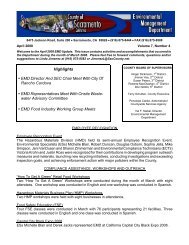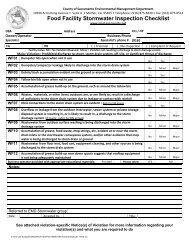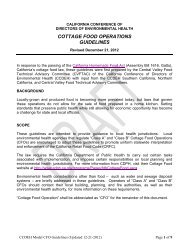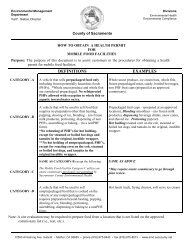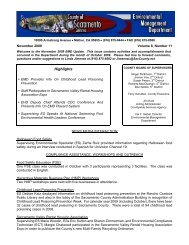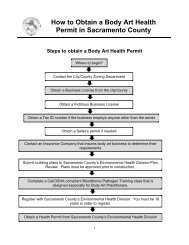California Water Well Standards, DWR Bulletin 74 ... - County of Glenn
California Water Well Standards, DWR Bulletin 74 ... - County of Glenn
California Water Well Standards, DWR Bulletin 74 ... - County of Glenn
- No tags were found...
Create successful ePaper yourself
Turn your PDF publications into a flip-book with our unique Google optimized e-Paper software.
Nested monitoring wells consist <strong>of</strong> two or more casing strings within the same borehole. Normally thescreened interval <strong>of</strong> each casing string is designed to obtain water from different aquifers or water'-bearingzones. The purpose <strong>of</strong> a nested monitoring well is much the same as clustered monitoring wells.Clustered monitoring wells consist <strong>of</strong> individual monitoring wells situated close together, but not in the sameborehole. The wells within a cluster are normally constructed to obtain water from different aquifers or waterbearingzones. Clustered wells are most <strong>of</strong>ten used for monitoring ground water conditions at various depthsin roughly the same area.A nested monitoring well can be difficult to construct because <strong>of</strong> multiple casings within the same borehole.Care is required during construction to ensure water-bearing zones for each casing string are hydraulicallyisolated from one another and the annular seals are effective. Some regulatory agencies may prohibit the use<strong>of</strong> nested monitoring wells for certain contamination or pollution investigations. Normally this can be dueto uncertainties about whether water-bearing strata can be isolated and whether the annular seals in a nestedwell are always effective.Individual casing strings for the various types <strong>of</strong> monitoring wells discussed above, are sometimes designed toobtain water from more than one aquifer or water-bearing unit. These casing strings usually have multipleintervals <strong>of</strong> openings or screen. Such well casing strings, <strong>of</strong>ten referred to as "multi-level monitoring wells,"can sometimes serve as a preferential pathway for the movement <strong>of</strong> poor quality water, pollutants, andcontaminants from one unit to another. Some regulatory agencies prohibit the use <strong>of</strong> multi-level monitoringwells for certain pollution or contamination investigations out <strong>of</strong> concern for water quality protection and dataquality requirements.Authority and Responsibilities <strong>of</strong> Other AgenciesAs discussed above, Congress enacted major legislation dealing with ground water quality protection duringthe 1970s. Regulatory programs initiated by federal legislation, such as the Resources Conservation andRecovery Act (RCRA) and its amendments, are administered by the U. S. Environmental Protection Agency.Some administration and enforcement activities related to federal legislation have been delegated to <strong>California</strong>State agencies.The <strong>California</strong> Legislature enacted legislation expanding efforts for ground water quality protection in<strong>California</strong> beyond federal requirements. The Legislature assigned several State agencies various responsibilitiesfor investigation, mitigation, and control <strong>of</strong> ground water pollution and contamination.The lead enforcement agency for most ground water quality protection issues in <strong>California</strong> is the State <strong>Water</strong>Resources Control Board (State Board) and the nine <strong>California</strong> Regional <strong>Water</strong> Quality Control Boards(Regional Boards). The State Board oversees the activities <strong>of</strong> the nine regional boards.The Department <strong>of</strong> Health Services or, under some circumstances, the U. S. Environmental Protection Agency,is the lead enforcement agency for ground water quality issues related to hazardous wastes.The EP A, the Department <strong>of</strong> Health Services, and the State Board have adopted regulations or standardsestablishing monitoring requirements for -Waste facilities-. These regulations or standards include requirements fordesign and perfO17nance <strong>of</strong> monitoring wells that are <strong>of</strong>ten more stringent than standards in this bulletin.Other State government organizations concerned or directly involved with ground water quality assessmentor protection in <strong>California</strong> include:.Department<strong>of</strong> Conservation, Division <strong>of</strong> Oil and Gas,-37-



